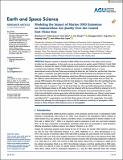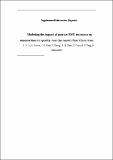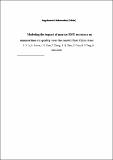Por favor, use este identificador para citar o enlazar a este item:
http://hdl.handle.net/10261/229222COMPARTIR / EXPORTAR:
 SHARE SHARE
 CORE
BASE CORE
BASE
|
|
| Visualizar otros formatos: MARC | Dublin Core | RDF | ORE | MODS | METS | DIDL | DATACITE | |

| Título: | Modeling the Impact of Marine DMS Emissions on Summertime Air Quality Over the Coastal East China Seas |
Autor: | Li, S.; Sarwar, G.; Zhao, J.; Zhang, Y.; Zhou, S.; Chen, Y.; Yang, Guang; Saiz-Lopez, A. CSIC ORCID | Palabras clave: | DMS flux SO2 Sulfate eastern China seas |
Fecha de publicación: | 8-oct-2020 | Editor: | American Geophysical Union | Citación: | Earth and Space Science 7: e2020EA001220 (2020) | Resumen: | Biogenic emission of dimethyl sulfide (DMS) from seawater is the major natural source of sulfur into the atmosphere. In this study, we use an advanced air quality model (CMAQv5.2) with DMS chemistry to examine the impact of DMS emissions from seawater on summertime air quality over China. A national scale database of DMS concentration in seawater is established based on a 5-year observational record in the East China seas including the Bohai Sea, the Yellow Sea, and the East China Sea. We employ a commonly used global database and also the newly developed local database of oceanic DMS concentration, calculate DMS emissions using three different parameterization schemes, and perform five different model simulations for July, 2018. Results indicate that in large coastal areas of China, the average DMS emissions flux obtained with the local database is 3 times higher than that resulting from the global database, with a mean value of 9.1 μmol m day in the Bohai Sea, 8.4 μmol m day in the Yellow Sea, and 13.4 μmol m day in the East China Sea. The total DMS emissions flux calculated with the Nightingale scheme is 42% higher than that obtained with the Liss and Merlivat scheme but is 15% lower than that obtained with the Wanninkhof scheme. Among the three parameterizations, results of the Liss and Merlivat scheme agree better with the ship-based observations over China's coastal waters. DMS emissions with the Liss and Merlivat parametrization increase atmospheric sulfur dioxide (SO) and sulfate (SO) concentration over the East China seas by 6.4% and 3.3%, respectively. Our results indicate that although the anthropogenic source is still the dominant contributor of atmospheric sulfur burden in China, biogenic DMS emissions source is nonnegligible. | Descripción: | 15 pags., 7 figs., 2 tabs. | Versión del editor: | http://dx.doi.org/10.1029/2020EA001220 | URI: | http://hdl.handle.net/10261/229222 | DOI: | 10.1029/2020EA001220 | Identificadores: | doi: 10.1029/2020EA001220 issn: 2333-5084 |
| Aparece en las colecciones: | (IQF) Artículos |
Ficheros en este ítem:
| Fichero | Descripción | Tamaño | Formato | |
|---|---|---|---|---|
| Modeling the Impact of Marine DMS.pdf | 9,21 MB | Adobe PDF |  Visualizar/Abrir | |
| Supplement.pdf | 422,3 kB | Adobe PDF |  Visualizar/Abrir | |
| Supplemental Information.pdf | 99,11 kB | Adobe PDF |  Visualizar/Abrir |
CORE Recommender
SCOPUSTM
Citations
7
checked on 18-abr-2024
WEB OF SCIENCETM
Citations
7
checked on 22-feb-2024
Page view(s)
96
checked on 18-abr-2024
Download(s)
117
checked on 18-abr-2024
Google ScholarTM
Check
Altmetric
Altmetric
Este item está licenciado bajo una Licencia Creative Commons

